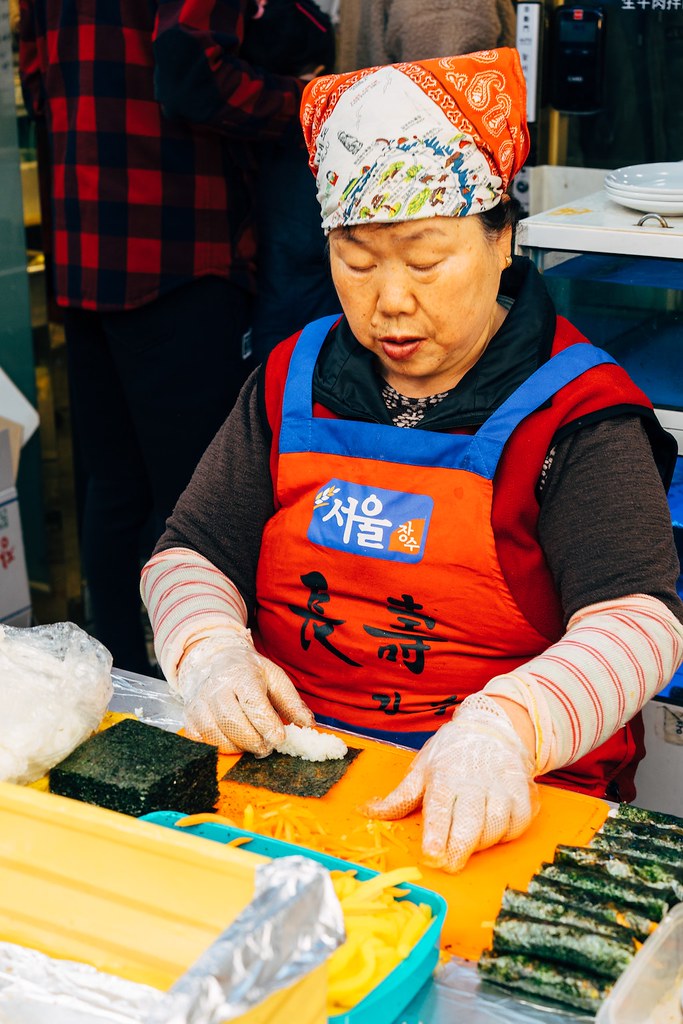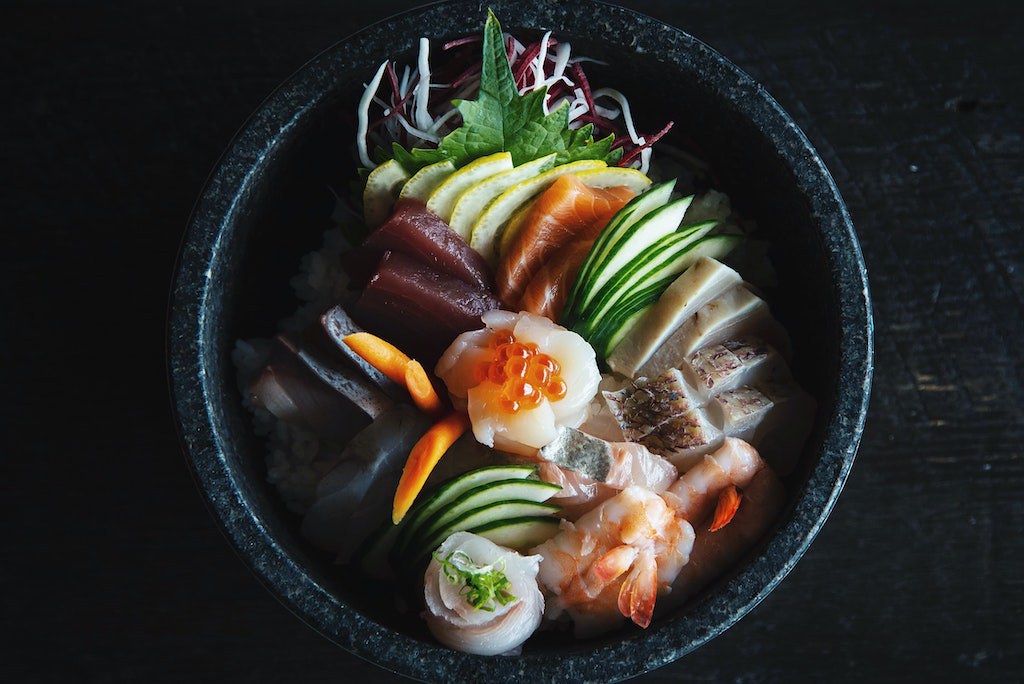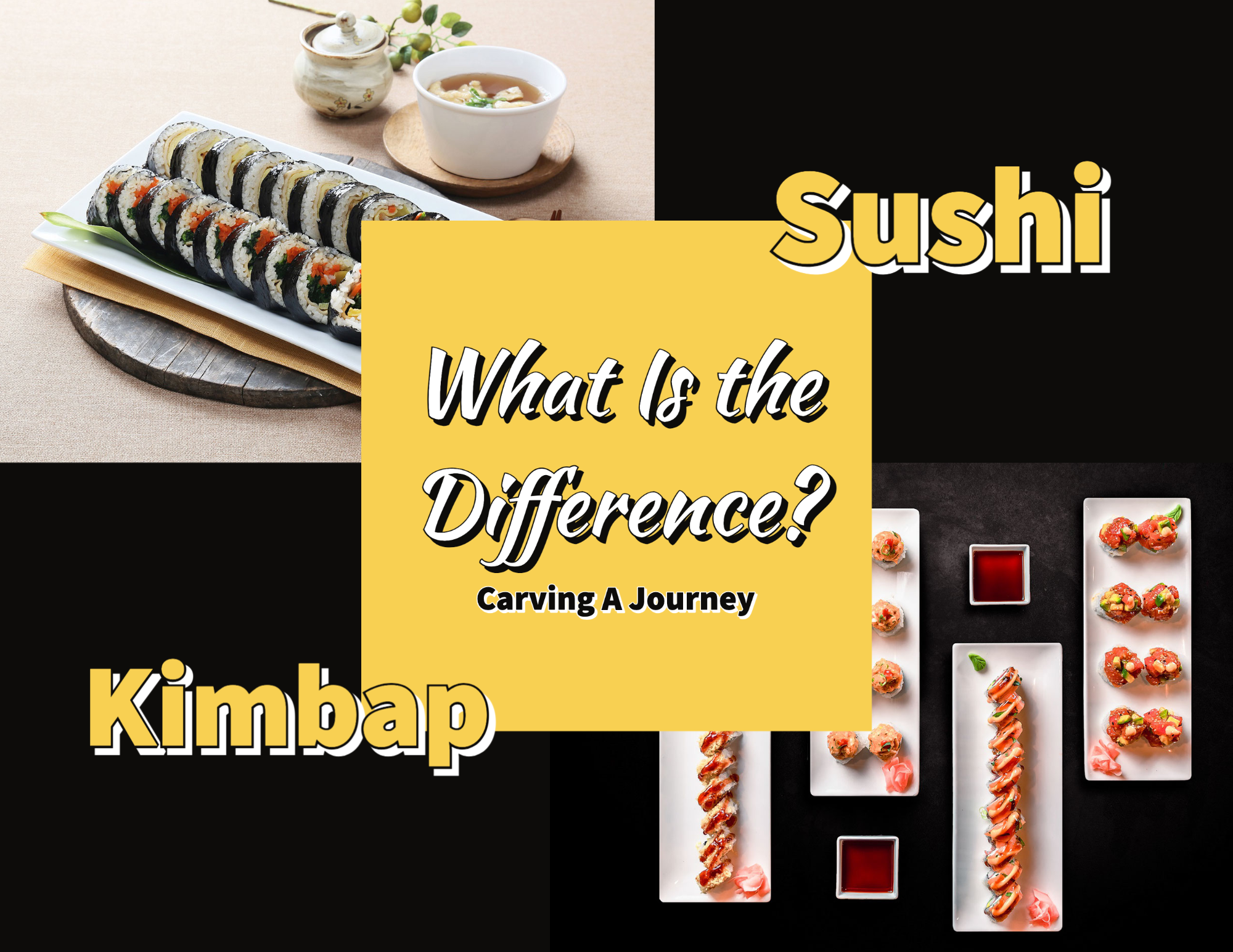Korean kimbap and Japanese rolled sushi–many people outside either culture often struggle to distinguish the difference. After all, the two dishes look almost identical at face value. Side-by-side, you may note that: Firstly, they both contain fillings at the center. Secondly, rice surrounds those filling ingredients. Lastly, dried sheets of seaweed are rolled around fillings and rice. But it is at this point that we reach the end of the similarities between the two. When it comes to the flavors and cooking process, Korean kimbap and Japanese sushi are entirely different. So, let’s ask the big question: Kimbap vs Sushi, what exactly is the difference?
First, before distinguishing the differences and comparing kimbap vs sushi, let’s look at the history, styles, cooking processes, and cultural aspects of each.
What Is Kimbap?
Kimbap (sometimes spelled as gimbap) is a traditional Korean dish made from different fillings, steamed rice, and dried sheets of seaweed. Once combined, the cooked rice and filling ingredients are rolled in dried seaweed. The word kimbap comes from ‘kim’ (or gim) which refers to the sheet of seaweed and ‘bap’ which refers to the cooked rice.

Kimbap Uses Fresh and Cooked Ingredients
History of Korean Kimbap
The history and origin story of Korean kimbap comes under much contention. You will get completely different stories depending on who you ask!
The Japanese claim Korean rolled recipes did not develop or emerge until the 20th century when Japan imperialized the Korean peninsula. The Japanese believe that, during this time, Koreans highly enjoyed norimaki (rolled seaweed version of sushi) and followed the Japanese cooking methods to develop versions using available Korean ingredients.
On the other hand, if you ask the general Korean population, they will say rolled rice in seaweed was developed long before the Japanese occupation. If one looks back to the 15th century, books such as Gyeongsang-do Jiriji and Sinjeung Dongguk Yeoji Seungnam mention the production of edible seaweed in Korea. Later on, during the Joseon dynasty (1392-1897), many documents show that Korean citizens wrapped cooked rice in seaweed. At the time, Koreans used the term bokssam. The word kimbap did not develop until much later.
Finally, we get to the last piece of the puzzle. Historians can link the term kimbap back to 1935 when a newspaper first used the term in an article. At the time Koreans used the Japanese word for rolled sushi, norimaki, interchangeably in written pieces and daily conversations. The term ‘norimaki’ first entered into Korean everyday conversation when the Japanese imperialized the Korean peninsula (1910-1945). During the Japanese occupation, they prohibited the use of the Korean language completely. No wonder Koreans used the term norimaki to refer to cooked rice rolled in seaweed, right?
The term kimbap appeared after the Japanese occupation ended. At this point, Koreans worked to remove remnants of Japanese influences entirely from their life including products, words, and teachings.
Obviously, kimbap has a convoluted history.
Treatment of Rice
Like we stated above, the ‘bap’ in kimbap refers to the cooked rice portion of the dish. Typically, one uses short-to-medium grain rice when cooking kimbap. Long grain rice contains less starch. Less starch results in grains that do not stick together well, thus not holding together enough to roll the kimbap. Short grained rice contains lots of starch making it perfect for kimbap!

Kimbap vs Sushi: Which Do You Prefer?
Additionally, Koreans often choose to use brown or black short-grained rice when making different styles of kimbap. For those outside of South Korea, white rice kimbap happens to be the most common. In South Korea, that isn’t always the case!
Finally, Koreans sometimes cut the rice with sesame oil and a little sugar. Koreans use sesame oil liberally in all of their cooking–kimbap is no exception. The sesame oil gives the dish a slight toasted nuttiness!
Filling Ingredients
In kimbap, Koreans use a mix of types of filling ingredients:
- Cooked: Unlike sushi, kimbap does not typically use raw fish. Instead, Koreans choose to use cooked protein such as canned tuna, bulgogi, spam, tofu, crab stick, sliced cheese, egg, and so on. At the same time, they cook much of the vegetables as well. Examples include sautéed spinach, carrots, and pan-fried kimchi.
- Raw: Like we just stated, raw protein is rarely, if ever, used. If you want raw-based Korean dishes, try eating yukhoe (marinated raw beef) or hoedeopbap (raw fish rice bowl). While kimbap doesn’t use raw protein, it does use raw vegetables. Examples include cucumber, perilla leaves, and leafy green lettuce.
- Preserved: Finally, Koreans also include pickled and preserved items in their kimbap. Most notably, you may find the yellow-colored, pickled daikon radish in your kimbap. The pickled daikon radish, danmuji, adds a sweet and crunchy aspect to kimbap.
Last but not least, Koreans often toast the dried seaweed sheet and brush on sesame oil to add another layer of the toasted and nutty flavors! You may even enjoy kimbap with toasted sesame seeds sprinkled on top!

A Vendor Rolling Chungmu Kimbap.
Styles of Kimbap
The types and styles of kimbap available are endless. When eating at kimbap stalls and restaurants you can find many different unique takes on the dish. Though that is the case, many claim there are 12 types that make up the most common and popular styles in Korea. Let’s look at them below:
Common Styles of Rolled Kimbap:
- Weonjo Kimbap: In Korea, this is the most common style of kimbap. Ingredients include ham or crab meat with veggies such as perilla, pickled daikon radish, and cucumber.
- Yachae Kimbap: For those who do not wish to eat meat or fish, try this version. It is vegetarian kimbap!
- Nalchial Kimbap: In this version, fish eggs are added over the top or inside the kimbap.
- Chamchi Kimbap: Koreans make this kimbap with canned tuna fish. A variation of this includes spicy tuna. To make spicy tuna, pan fry your tuna with some kimchi!
- Sogogi Kimbap: The main protein of this version is beef! Often, people enjoy bulgogi kimbap as well.
- Chungmu Kimbap: These are mini kimbap rolls. Typically, these are made with just rice and seaweed. They are then served with spicy side dishes and sauces. Examples of some sides include squid salad and radish kimchi.
- Chijeu (Cheese) Kimbap: Koreans enjoy cheese kimbap as well!
- Gyeran Kimbap: Gyeran means egg in Korean. Typically, Koreans cook and wrap the egg around the outside of the seaweed.
- Nudeu (Nude) Kimbap: This version includes rice on the outside of the kimbap roll.
- Kimchi Kimbap: For this, Koreans include kimchi in the roll.
- Donkkaseu (Tonkatsu) Kimbap: Koreans add pork cutlet when making this type of kimbap. They batter and fry the pork cutlet before adding it into the kimbap. Typically, donkkaseu kimbap is extremely crunchy because of the batter!
Specialty Kimbap: Triangle Kimbap
Samgak Kimbap: Unlike all the other versions, Koreans form this kimbap into a triangle instead of rolling it into a cylinder. Triangle Kimbap is a popular cheap, convenience store version based on Japanese onigiri. You can find this in kimbap restaurants, at corner stores, and your grocery market. Also, people make this version at home to take on picnics or eat at their desk. You can learn how to make triangle kimbap via our blog post!

A Tray of Triangle Kimbap,
If you want to make triangle kimbap, we recommend getting a mold Koreans use to make this dish!
Now, let’s take a look at sushi as we continue to compare kimbap vs sushi.
What is Sushi?
Sushi is a Japanese dish made by placing specially prepared vinegar-soaked rice together with different fillings such as raw or cooked seafood and vegetables.
Sushi is a broader Japanese food category than the Korean kimbap equivalent. Unlike kimbap, sushi doesn’t even need to be rolled in seaweed. Mainly, the concept and term ‘sushi’ comes from the type of rice preparation.

Rolled Sushi
History of Japanese Sushi
We can trace sushi back to the 2nd century. At the time, the Japanese stored fish in fermented rice for months at a time to preserve for later consumption. Typically, they would then discard the rice before consumption. This style of fish preservation is known as narezushi (salted fish). The term sushi literally means ‘sour-tasting,’ and comes from an antiquated dialect no longer used.
For reference, if you would still like to try this traditional way of making narezushi ‘sushi,’ travel to the Shiga Prefecture of Japan. They continue to make a regional version of this specialty called funa-zushi.
Over time, the Japanese no longer needed the original fermentation method because the cooking and preservation processes improved in Japan. During the Edo period (1603-1868), they started eating fresh and raw fish over vinegared rice and nori. Nori refers to the dried seaweed sheets.
However, the Japanese did not invent norimaki (rolled sushi) until 1716. Ryori Sankai Kyo, a historical Japanese text documenting food and production in Japan, notes the invention of norimaki took place at that point in time.

To Cut Kimbap and Sushi, You Need a Sharp Knife!
Treatment of Rice
Sushi refers to the sour flavor produced by adding vinegar to rice. Rice is the most important element, not the vegetables, meat, or seafood. In Japan, they strongly believe that if you have high-quality ingredients with poor rice preparation, the sushi isn’t delicious or of good quality. The rice is truly a focus and art form.
Unlike kimbap, traditional Japanese sushi always uses short-grained white rice. They then cut the rice with vinegar.
Sushi Fillings
Unlike kimbap, sushi is famous for the use of raw seafood. Below are some examples of sushi ingredients:
- Raw: The Japanese use raw fish such as tuna, salmon, chopped scallops, mackerel, and so on. At the same time, they often use raw vegetables such as cucumbers.
- Cooked: Sometimes, the Japanese use cooked items as well. The most famous examples would include cooked eel or egg.
- Preserved: Famously, the Japanese serve pickled ginger with their sushi. The ginger acts as a palate cleanser when eating different types of fish.
Styles of Sushi
Like kimbap, sushi can be made in a multitude of different ways. Unlike kimbap, the difference in styles is not solely based on the filling ingredients. Sushi doesn’t even have to come as a roll or use dried seaweed as an ingredient! Below are examples of different types of sushi:

A Sushi Chef.
6 Common Styles of Sushi
- Chirashizushi: In English, this means ‘scattered sushi’. The Japanese make a rice bowl and top it with a variety of different types of raw fish and vegetables. Often, Japanese chefs design the rice bowls artfully to beautifully display the fish.
- Inarizushi: In Japan, they make this style of sushi by deep frying tofu. Then, they create a pocket in the tofu where they place the rice
- Makizushi: This version is also known as norimaki ‘nori roll.’ For reference, this is the sushi style that often gets confused with Korean kimbap. The Japanese add rice onto a sheet of dried seaweed. Then, once they add the fillings onto the rice, they roll everything up into a cylinder. Finally, they cut the cylinder into bite-sized pieces. This style alone has a multitude of versions. Examples include hosomaki (a version with only one type of filling ingredient), tekkamaki (a type of hosomaki with tuna in the middle), ehomaki (a roll using seven lucky ingredients), and so on.
- Narezushi: This is a traditional type of fermented sushi. First, the Japanese gutted the fish and stuff them with salt. They then leave the fish to ferment. Finally, after approximately 6 months, the sushi can be eaten.
- Nigirizushi: In English, this means ‘hand-pressed sushi’. A chef presses sushi rice with their hands creating an oval-shaped ball. Then, the chef adds the sliced raw fish on top of the molded rice.
- Oshizushi: In English, this means ‘pressed sushi’. With this version, the Japanese use molding blocks to press the rice and fish into rectangular pieces.
And so on…
As you can see, the Japanese have a much larger definition of sushi than the type made with dried seaweed!
For reference, in case there is any confusion, sashimi is a related dish that consists of thinly sliced raw fish or meat. You then solely serve the raw fish or seafood on a plate or platter–you can serve an optional bowl of plain steamed rice (no vinegar) on the side. The Japanese do not serve sashimi on top of the rice.

A Sushi Bowl: Chirashizushi.
Kimbap vs. Sushi: What Is the Difference?
In the end, the difference between kimbap and sushi comes down to three major components:
- How Korea and Japan Culturally Define Their Dish: In Korea, kimbap solely refers to rice rolled in seaweed. In Japan, sushi can refer to a multitude of dishes that use vinegared rice.
- The Types of Fillings Added: In Korea, they add cooked ingredients to their kimbap. In Japan, they add raw ingredients to their sushi.
- How They Treat the Rice: In Korea, people use sesame oil to flavor their rice for kimbap. In Japan, they add vinegar to their rice for sushi.
We hope this helped with understanding the question we started with-kimbap vs sushi: what is the difference?
Making Kimbap and Sushi at Home
If you would like to make kimbap or sushi at home, you may need:
- A Bamboo Mat Kit (used to roll the kimbap and sushi)
- Dried Seaweed
- Short Grained Rice
- Sesame Oil (for kimbap)
- Rice Vinegar (for Sushi)
Remember, if you decide to use raw fish, please carefully pick ingredients deemed safe to consume!
In Conclusion: Kimbap vs Sushi
In the end, two very geographically close countries developed very similar dishes on their own. Maybe they developed similarly because of comparable living situations and terrains. On the other hand, maybe they influenced one another long ago through trade and commerce.
No matter what, even if the kimbap and sushi histories tend to get muddled because of political animosity, I believe everyone can agree that the two countries made dishes that taste uniquely different and equally delicious!
If you have any questions, please leave a comment below or email us at [email protected]. We love hearing from you! We hope you enjoyed learning all about kimbap vs sushi! Finally, we also love hearing from you through our social media! You can follow us at @carvingajourney on Instagram, Twitter, Facebook, and Pinterest. In the end, if you like articles like kimbap vs sushi, you can subscribe to our blog by joining our mailing list.
Carving A Journey is a participant in the Amazon Services LLC Associates Program, an affiliate advertising program designed to provide a means for sites to earn advertising fees by advertising and linking to Amazon.com. Although we may earn commissions for our endorsement, recommendation, testimonial, and/or link to any products or services from this website, these opinions are my own and I fully support these products.


2 comments
Amazing job writing this article. Very comprehensive and accurate without any bias.
Thank you so much! I appreciate you commenting this!